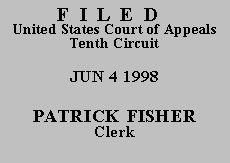

| JON W. SHAFFER,
Plaintiff-Appellant, v. KENNETH S. APFEL, Commissioner, Social Security Administration,(*) Defendant-Appellee. |
|
Plaintiff Jon W. Shaffer appeals from an order of the district court affirming the Commissioner's determination that he is not entitled to disability benefits. We affirm.
We review the Commissioner's decision to determine whether his factual findings were supported by substantial evidence in light of the entire record and to determine whether he applied the correct legal standards. See Castellano v. Secretary of Health & Human Servs., 26 F.3d 1027, 1028 (10th Cir. 1994). Substantial evidence is "such relevant evidence as a reasonable mind might accept as adequate to support a conclusion." Id. (quotations omitted). In the course of our review, we may "neither reweigh the evidence nor substitute our judgment for that of the agency." Casias v. Secretary of Health & Human Servs., 933 F.2d 799, 800 (10th Cir. 1991).
Mr. Shaffer alleged disability due to the effects of a back injury and arthritis affecting multiple joints. The administrative law judge (ALJ) determined that Mr. Shaffer was not disabled at step five of the five-step sequential process, see Williams v. Bowen, 844 F.2d 748, 750-52 (10th Cir. 1988), finding that he could perform light work with only temperature and humidity restrictions.
On appeal, Mr. Shaffer argues the ALJ erred in finding that Mr. Shaffer could do the prolonged standing necessary to perform light work and he failed to properly link his credibility findings to Mr. Shaffer's complaints of pain. He also asserts the ALJ erroneously failed to shift the burden of proof to the Commissioner before he made the residual functional capacity (RFC) determination.
Light work requires that the claimant be able to do a "good deal of walking or standing or . . . sitting most of the time with some pushing and pulling of arm or leg controls." 20 C.F.R. § 404.1567(b). Mr. Shaffer has been diagnosed with degenerative joint disease in his knees. He testified that he drives 200 miles a week to run errands, although he is house bound when the temperature gets below forty degrees. He can walk under a mile or for about thirty minutes before his knees swell. He does housework, some gardening, and can carry three one-liter bottles of soda. The medical evidence shows that he has normal range of motion and gait.
Mr. Shaffer argues that even if the ALJ is correct that he was not disabled in 1992 and 1993, by 1994, his condition had deteriorated due to marked arthritic changes in his knees. The record shows that, in 1994, various physicians noted Mr. Shaffer had some osteostatic changes, his knees were slightly tender, and he had marked creptitus. No physician has placed any restrictions on Mr. Shaffer's ability to stand. Indeed, one physician noted that Mr. Shaffer was "experiencing satisfactory relief of his symptoms," App. Vol. II at 267; another suggested that he begin a walking program, id. at 259; and a third reported that Mr. Shaffer stated that he "occasionally" has "continual pain" in his knee which is affected by stair climbing, id. at 268. The vocational expert opined that jobs exist in the light work category which Mr. Shaffer can perform with his limitations. The record supports the ALJ's determination that Mr. Shaffer can perform light work.
Mr. Shaffer asserts the ALJ failed to make the proper linkage between his credibility findings and Mr. Shaffer's complaints of pain. In evaluating a claimant's pain, the ALJ must consider the level of medication the claimant uses and its effectiveness, the claimant's attempts to obtain relief, the frequency of his medical contacts, the nature of his daily activities, his credibility, and the consistency or compatibility of nonmedical testimony with objective medical evidence. See Kepler v. Chater, 68 F.3d 387, 391 (10th Cir. 1995). "Credibility determinations are peculiarly the province of the finder of fact, and we will not upset such determinations when supported by substantial evidence." Diaz v. Secretary of Health & Human Servs., 898 F.2d 774, 777 (10th Cir. 1990).
While the ALJ could have discussed these factors more extensively, we see no legal error. Mr. Shaffer's daily activities are fairly comprehensive. He takes pain medication, but his treating physicians have indicated that the medication controls his pain effectively. He seeks regular medical intervention, but no physician has indicated that intervention has been ineffective or that Mr. Shaffer has been incapacitated by his medical problems. The ALJ's credibility determination is well supported by the record.(1)
Finally, Mr. Shaffer contends the ALJ erroneously failed to shift the burden of proof to the Commissioner until after he made the RFC determination. The RFC determination is initially part of the step four evaluation and, thus, is made before the burden of proof shifts at step five. See Hinkle v. Apfel, 132 F.3d 1349, 1352 (10th Cir. 1997); 20 C.F.R. § 1520(e), (f). No error occurred.
The judgment of the United States District Court for the Northern District of Oklahoma is AFFIRMED.
Entered for the Court
Circuit Judge
*. Pursuant to Fed. R. App. P. 43(c), Kenneth S. Apfel is substituted for John J. Callahan, former Acting Commissioner of Social Security, as the defendant in this action.
**. This order and judgment is not binding precedent, except under the doctrines of law of the case, res judicata, and collateral estoppel. The court generally disfavors the citation of orders and judgments; nevertheless, an order and judgment may be cited under the terms and conditions of 10th Cir. R. 36.3.
1. We note, although the ALJ did not consider this fact, that Mr. Shaffer told his treating physician in 1991 that he quit his job because of unsatisfactory work conditions, not because of any physical impairment. See App. Vol. II at 121.